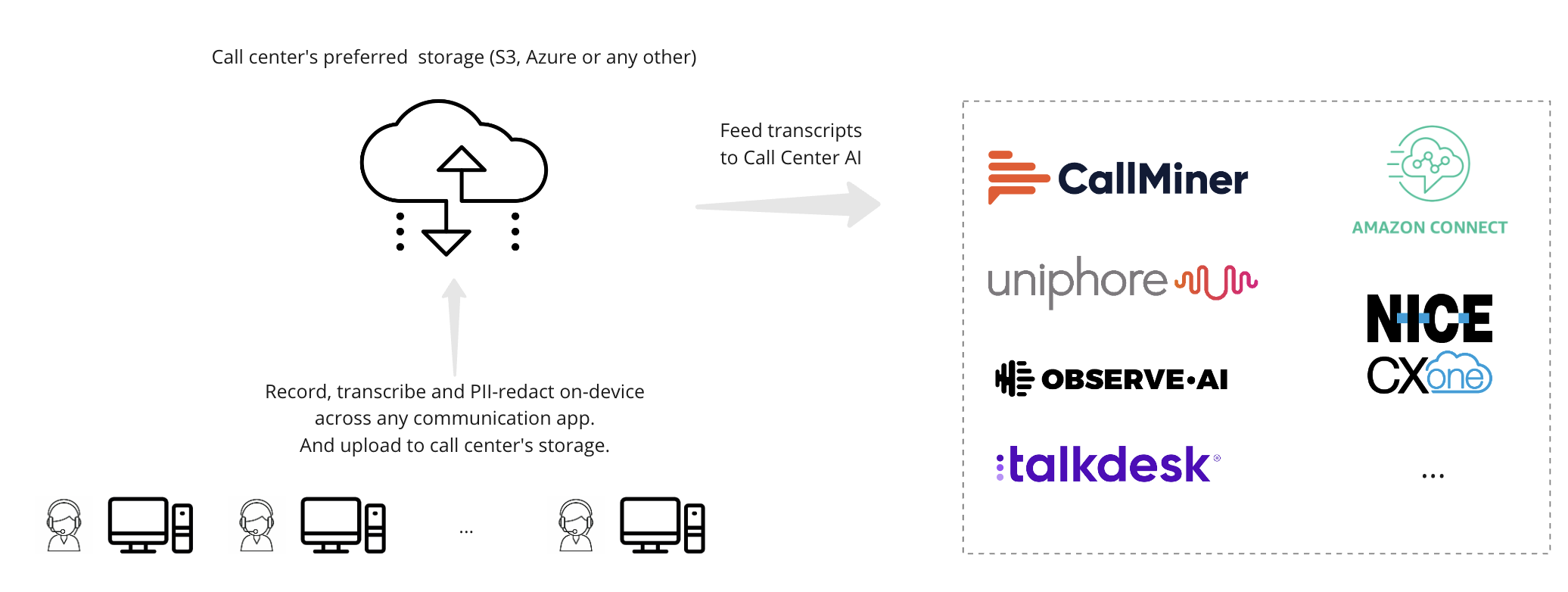With advancements in on-device transcription software, the call center industry is on the brink of a transformative change. It’s time to rethink the traditional approach of cloud-based transcriptions and bring the process directly onto the agents’ devices.
On-device transcription software processes speech-to-text conversions directly on the device, without relying on cloud-based services. This method leverages local computational power to perform transcription tasks, ensuring data is processed quickly and securely.
The software uses advanced machine learning algorithms and neural networks to recognize and transcribe speech in real time. Utilizing the device’s hardware minimizes latency and enhances the accuracy of transcriptions.
Benefits of On-Device Transcription in Call Centers
Call centers handle vast amounts of data daily, making efficient transcription crucial. On-device transcription software addresses several key areas to optimize call center operations Main advantages of speech-to-text solutions include:
✔ Enhanced Privacy and Security: Security is a major concern in the call center industry, especially when handling sensitive customer information. On-device transcription ensures that audio stays on the device, significantly lowering the risk of data breaches. This approach complies seamlessly with strict data protection regulations, assuring both call centers and their customers.
✔ Improved Speed: Real-time processing eliminates delays associated with data transfer to and from cloud servers. Also, this feature can be a game-changer, enabling agents to see a real-time transcript of the call.
✔ Cost-Effectiveness: The most immediate benefit of on-device transcription is cost savings. Traditional cloud transcription services are very expensive due to the costs associated with audio data transmission and processing on remote servers. On-device transcription, however, leverages the processing power of the agent’s device, leading to a significant reduction in these costs.

What is Behind On-Device Transcription Technology?
On-device transcription technology is grounded in advanced artificial intelligence and machine learning. Here’s a detailed look at how it works:
- Speech Recognition Algorithms: These algorithms convert spoken language into text by analyzing audio signals. They break down the audio into smaller units called phonemes, which are then matched with known language patterns.
- Natural Language Processing (NLP): NLP techniques help the software understand context, grammar, and syntax, improving the accuracy of transcriptions.
- Acoustic Models: These models analyze the properties of sound waves to distinguish between different words and sounds, even in noisy environments.
- Language Models: Language models predict the next word in a sequence, helping to correct errors and improve transcription quality.
Overcoming Historical Challenges of On-Device Transcription in Call Centers
Historically, on-device transcription wasn’t an option for several reasons:
Hardware Limitations
The CPU requirements for on-device transcription could exceed the capabilities of existing hardware in call centers, requiring costly upgrades. However, this challenge is being rapidly addressed by two factors:
- Speech-to-text technologies have become significantly more efficient in terms of CPU and memory requirements, making them capable of running locally.
- The influx of AI-powered laptops and workstations from Intel, AMD, and Qualcomm designed to handle such tasks efficiently.
Integration Challenges
Historically, integrating on-device transcription with various call center systems and software was complex, requiring significant technical effort and resources. However, with the integration of cloud systems in call centers, this is no longer a challenge. The transcriptions and recordings generated on agents’ devices can be easily uploaded to AWS, Google, Azure, or other cloud storage and then fed into Call Center AI solutions such as CallMiner, Observe AI, AWS Connect, NICE, etc.
Low Transcription Quality
Historically, on-device solutions yielded lower-quality transcriptions since only small models could be deployed on the device, and there was limited access to the latest AI models and updates available in cloud-based systems. However, progress in Speech-to-text models and the availability of better CPUs makes it possible to successfully deploy and run high-quality efficient models on-device.
Comparing On-Device and Cloud-Based Transcription for Call Centers
To better understand the benefits of on-device transcription, let’s compare it to cloud-based transcription services in a few key areas.
This comparison will highlight why on-device solutions are becoming increasingly favored in the industry.
| Feature | On-Device Transcription | Cloud-Based Transcription |
|---|---|---|
| Privacy | ✅ High – Data processed locally | ❌ Medium – Data transmitted to the cloud |
| Speed | ✅ High – Real-time processing | ✅ Variable – Dependent on internet speed |
| Cost | ✅ Lower ongoing costs | ❌ Higher ongoing costs due to service fees |
| Scalability | ✅ Variable – Dependent on device capability | ✅ Highly scalable with cloud resources |
| Reliability | ✅ High – Less dependent on the internet | ✅ Variable – Dependent on internet connectivity |
Choose your On-Device Transcription Software
Here are six top on-device transcription software options that can streamline your operations:
1. Krisp
Krisp offers powerful on-device transcription capabilities that seamlessly convert call conversations into text. With its robust noise-canceling technology, Krisp ensures that only clear and relevant speech is transcribed, making it a top choice for call centers looking for reliable and accurate transcriptions.
2. Otter.ai
Otter.ai is renowned for its advanced AI-driven transcription services. It provides real-time transcription and features collaborative tools for team-based environments, making it an excellent fit for call centers that require quick and precise transcriptions.
3. Sonix
Sonix offers fast and accurate transcription services with a focus on security and data privacy. It supports multiple languages and provides powerful editing tools to refine transcriptions, which is beneficial for call centers handling international clients.
4. Trint
Trint utilizes AI to deliver highly accurate transcriptions that can be edited and shared within the team. Its robust platform supports integrations with various CRM systems, ensuring seamless workflow integration for call centers.
5. Rev
Rev provides on-device transcription with a strong emphasis on accuracy and speed. It offers user-friendly tools to manage and edit transcripts, making it a reliable choice for call centers that require quick turnaround times.
6. Descript
Descript is a versatile transcription software that combines transcription with video and audio editing features. Its unique approach allows call centers to not only transcribe calls but also create and edit media content, making it a multifunctional tool for various needs.
Krisp: Best On-Device Call Center Transcription Software
As we conclude our exploration of on-device transcription for call centers, it’s clear that selecting the right tool is crucial. Indeed, Krisp stands out, providing unmatched accuracy, usability, and integration.



With Krisp, call centers can enjoy:
- Superior Transcription Accuracy 96% : Leveraging cutting-edge AI, Krisp ensures high-quality transcriptions, even in noisy environments. Furthermore, Krisp CCT delivers unmatched transcription accuracy with a WER (Word Error Rate) of only 4%.
- On Device Processing: Krisp’s desktop app processes transcriptions and noise cancellation directly on your device, thereby keeping sensitive info secure and compliant with strict security standards.
- Unmatched privacy: Krisp ensures the utmost privacy by redacting PII and PCI in real-time, storing transcripts in a private cloud owned by customers with write-only access.
- A single solution across all platforms: By centralizing call transcriptions across all platforms, Krisp CCT optimizes costs and simplifies data management, eliminating the need for multiple transcription services.
- No additional integrations required: Krisp’s plug-and-play setup integrates effortlessly with major CCaaS and UCaaS platforms. Requiring no additional configurations, Krisp ensures your operations run smoothly and securely.
How Krisp Call Center Transcription works technically
Krisp Call Center Transcription employs noise-robust deep learning algorithms for real-time on-device speech-to-text conversion. Specifically, the process consists of several stages:
- Processes and turns speech into unformatted text.
- Adds punctuation, capitalization, and numerical values.
- Removes PII/PCI and filler words on-device and in real time.
- Assigns text to speakers with timestamps.
- Temporarily stores the encrypted transcript locally.
- Safely transmits the transcript to a private cloud.
Krisp System Architecture Detailed
At Krisp, we utilize advanced Speech-to-text models that operate directly on-device. These models are not only highly efficient but also produce high-quality transcriptions. Importantly, they are designed to redact PII and are compatible with over 100 call center communication applications.
The following diagram shows how Krisp would typically be deployed in call centers.
- Automatically install Krisp on all agents devices
- Krisp will transcribe and record all agent calls from any CX solution or SoftPhone (e.g. Genesys, TalkDesk, Avaya, etc)
- Krisp will redact PII on-device and upload the final transcription and recording to call center’s preferred storage (e.g. S3, Azura, FTP, etc).
- The transcription and recording will be fed to Call Center AI for further processing

See Krisp Call Center Transcription in action
Summing up
On-device transcription software is a game-changer for call centers, offering enhanced data management, workflow efficiency, and security. By processing speech-to-text conversions directly on agents’ devices, it reduces latency, improves accuracy, and significantly lowers operational costs. Solutions like Krisp, with their advanced features and seamless integration, are ideal for call centers looking to optimize their operations. Krisp’s state-of-the-art on-device transcription technology ensures faster, more secure, and cost-effective transcription processes, making it a top choice for modern call centers seeking to enhance their performance.


